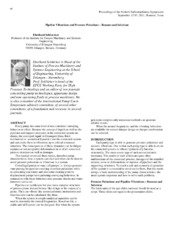| dc.contributor.other | International Pump Users Symposium (27th : 2011) | |
| dc.creator | Schlücker, Eberhard | |
| dc.date.accessioned | 2017-09-19T21:05:58Z | |
| dc.date.available | 2017-09-19T21:05:58Z | |
| dc.date.issued | 2011 | |
| dc.identifier.uri | https://hdl.handle.net/1969.1/162597 | |
| dc.description | Tutorial | en |
| dc.description.abstract | Every pump has some kind of non-continual conveying behavior or effect. Because the conveyed liquids as well as the pipelines and support structures in the connected system are elastic, the conveyed liquid will transport these fluidmechanical or -acoustical dynamics into the connected system and can excite them to vibrations up to critical resonance situations. The consequences of these dynamics can be fatigue ruptures or not acceptable deformations at or of all connected parts or structures as well as damages. This tutorial covers all these topics, describes pump characteristics, how a system can react and what can be done to avoid pressure pulsations or vibrations in a system. Centrifugal pumps or vane cell pumps i.e. always generate vane passing frequencies resulting in certain pulsations while reciprocating machinery and also some rotating positive displacement pumps have pulsating conveying behaviors. In connection with these behaviors also pressure shocks and water hammers can occur. Pipelines or cantilevers but also more complex structures of process plants instead behave like strings or the corpus of a guitar. They can vibrate like acoustical music instruments and therefore also can be calculated like these. When the system is simple analytical equations can be used to determine the natural frequencies. Based on this, a stable and stiff system can be designed. But when the system gets more complex only numerical methods can generate reliable results. When the natural frequencies and the vibrating behaviors are available the correct damper design or damper combination can be selected. | en |
| dc.format.medium | Electronic | en |
| dc.format.mimetype | application/pdf | |
| dc.language.iso | en | |
| dc.publisher | Turbomachinery Laboratory, Texas A&M University | |
| dc.relation.ispartof | Proceedings of the 27th International Pump Users Symposium | en |
| dc.subject.lcsh | Pumping machinery | en |
| dc.title | Pipeline Vibrations And Pressure Pulsations—Reasons And Solutions | en |
| dc.type.genre | Presentation | en |
| dc.type.material | Text | en |
| dc.identifier.doi | https://doi.org/10.21423/R1MD1C | |


